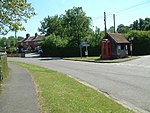Breamore railway station

Breamore railway station was a railway station in the Avon Valley at the village of Breamore, Hampshire, England. The station was built for the Salisbury and Dorset Junction Railway and opened in 1866. It was served by trains between Salisbury in Wiltshire and West Moors in Hampshire. British Railways closed the station and the line on 2 May 1964. The station has survived intact, and in recent years has been refurbished. Five affordable homes were built for the Hampshire Alliance for Rural Affordable Housing (HARAH) on one of the disused platforms, being completed in December 2012.A 2-mile section of the disused railway line which passes through the station has been converted into a footpath
Excerpt from the Wikipedia article Breamore railway station (License: CC BY-SA 3.0, Authors, Images).Breamore railway station
Woodgreen Road, New Forest
Geographical coordinates (GPS) Address Nearby Places Show on map
Geographical coordinates (GPS)
| Latitude | Longitude |
|---|---|
| N 50.95851 ° | E -1.77356 ° |
Address
Woodgreen Road
Woodgreen Road
SP6 2EB New Forest
England, United Kingdom
Open on Google Maps









